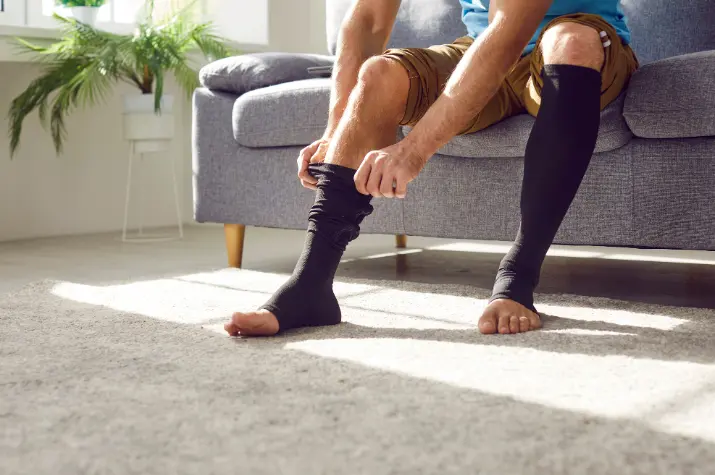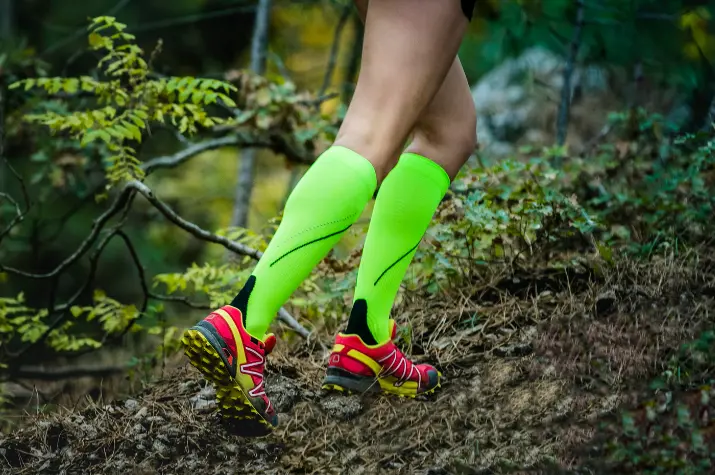
Whether you’re an avid athlete or just enjoy a good workout, you may have heard about the benefits of wearing compression socks afterward. These snug-fitting garments have gained popularity among fitness enthusiasts for several reasons.
Let’s delve into why wearing compression socks post-workout could be beneficial for you:
1. Enhanced Recovery
After an intense workout, your muscles need time to recover and repair. Compression socks for men and women can play a vital role in facilitating this process. These snug-fitting garments apply graduated pressure to the muscles in your legs, promoting better blood flow and reducing muscle soreness.
By improving circulation, compression socks help deliver oxygen and nutrients to your muscles more efficiently, while also aiding in the removal of metabolic waste products.
This enhanced nutrient delivery and waste removal can accelerate the recovery process, allowing you to bounce back faster and perform at your best during subsequent workouts.
Moreover, compression socks provide support to your lower leg muscles, reducing the risk of overuse injuries and promoting better alignment and stability. This added support can be particularly beneficial for athletes who engage in high-impact activities like running, jumping, or weightlifting.
By reducing muscle vibration and oscillation, compression socks help minimize muscle damage and fatigue, enabling you to train harder and longer with less risk of injury.
Additionally, compression socks can help prevent swelling and inflammation, which are common after strenuous exercise. The gentle pressure exerted by the socks helps prevent fluid buildup in the tissues, keeping your legs feeling fresh and rejuvenated post-workout.
Whether you’re a professional athlete or a weekend warrior, incorporating compression socks into your recovery routine can make a significant difference in how quickly you bounce back from intense training sessions.
2. Reduced Muscle Fatigue

One of the main benefits of compression socks is their ability to reduce muscle fatigue during and after exercise. The graduated compression provided by these socks helps support your muscles, reducing vibration and oscillation as you move.
This stabilization can lead to less muscle damage and fatigue, allowing you to push yourself harder and recover faster.
Additionally, compression socks can help improve proprioception or the awareness of your body’s position and movement in space.
By providing feedback to your muscles and joints, compression socks can enhance your overall performance and reduce the risk of injury during workouts.
3. Improved Circulation
Proper blood flow is essential for delivering oxygen and nutrients to your muscles during exercise and removing waste products afterward. Compression socks work by gently squeezing the muscles in your legs, which helps push blood back toward your heart.
By improving circulation, compression socks can help reduce the risk of conditions like deep vein thrombosis (DVT) and blood clots, particularly during long periods of sitting or immobility.
Additionally, better circulation means faster delivery of oxygen and nutrients to your muscles, promoting quicker recovery after workouts.
4. Enhanced Endurance

Wearing compression socks during and after workouts may also help improve your endurance over time. By reducing muscle fatigue and improving circulation, these socks can help you maintain optimal performance for longer periods, whether you’re running, cycling, or lifting weights.
Studies have shown that athletes who wear compression garments during exercise experience less muscle soreness and fatigue afterward, allowing them to train at higher intensities and volumes. Over time, this can lead to greater gains in strength, endurance, and overall fitness.
5. Preventive Measure
In addition to their benefits for recovery and performance, compression socks can also serve as a preventive measure against certain injuries. For example, wearing compression socks during activities that involve repetitive movements, such as running or jumping, may help reduce the risk of conditions like shin splints and Achilles tendonitis.
Compression socks can also provide extra support to your ankles and arches, which can be beneficial for individuals with a history of ankle sprains or foot injuries.
By stabilizing the muscles and ligaments in your lower legs, compression socks can help prevent overpronation and other biomechanical issues that can lead to injury.
Remember to choose compression socks that fit properly and provide the right level of compression for your needs. With the right pair of compression socks, you can optimize your workout recovery and get back to doing what you love with less downtime.
About The Author:
Stacey Smith is a freelance health writer. She is passionate about writing about women’s health, dental health, diabetes, endocrinology, and nutrition and provides in-depth features on the latest health news for medical clinics and health magazines.




